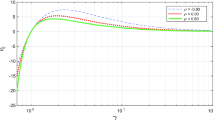Abstract
The optimal investment problem is studied for a continuous time incomplete market model. It is assumed that the risk-free rate, the appreciation rates, and the volatility of the stocks are all random; they are independent from the driving Brownian motion, and they are currently observable. It is shown that some weakened version of Mutual Fund Theorem holds for this market for general class of utilities. It is shown that the supremum of expected utilities can be achieved on a sequence of strategies with a certain distribution of risky assets that does not depend on risk preferences described by different utilities.
Similar content being viewed by others
References
Brennan, M. J. (1998). The role of learning in dynamic portfolio decisions. European Finance Review, 1, 295–306.
Dokuchaev, N. (2010a). Mean variance and goal achieving portfolio for discrete-time market with currently observable source of correlations. ESAIM: Control, Optimisation and Calculus of Variations, 16, 635–647.
Dokuchaev, N. (2010b). Predictability on finite horizon for processes with exponential decrease of energy on higher frequencies. Signal Processing, 90(2), 696–701.
Dokuchaev, N., & Haussmann, U. (2001). Optimal portfolio selection and compression in an incomplete market. Quantitative Finance, 1, 336–345.
Feldman, D. (2007). Incomplete information equilibria: Separation theorems and other myths. Annals of Operations Research, 151, 119–149.
Karatzas, I., & Shreve, S. E. (1998). Methods of mathematical finance. New York: Springer.
Khanna, A., & Kulldorff, M. (1999). A generalization of the mutual fund theorem. Finance and Stochastics, 3, 167–185.
Krylov, N. V. (1980). Controlled diffusion processes. New York: Springer.
Li, D., & Ng, W. L. (2000). Optimal portfolio selection: Multi-period mean-variance optimization. Mathematical Finance, 10(3), 387–406.
Lim, A. (2004). Quadratic hedging and mean-variance portfolio selection with random parameters in an incomplete market. Mathematics of Operations Research, 29(1), 132–161.
Lim, A. (2005). Mean-variance hedging when there are jumps. SIAM Journal of Control and Optimization, 44, 1893–1922.
Lim, A., & Zhou, X. Y. (2002). Mean-variance portfolio selection with random parameters in a complete market. Mathematics of Operations Research, 27(1), 101–120.
Merton, R. (1969). Lifetime portfolio selection under uncertainty: The continuous-time case. Review of Economics and Statistics, 51, 247–257.
Revuz, D., & Yor, M. (1999). Continuous martingales and Brownian motion. New York: Springer.
Schachermayer, W., Srbu, M., & Taflin, E. (2009). In which financial markets do mutual fund theorems hold true? Finance and Stochastics, 13, 49–77.
Shilov, G. E., & Gurevich, B. L. (1967). Integral, measure and derivative: A unified approach. Moscow: Nauka.
Acknowledgments
This work was supported by ARC Grant of Australia DP120100928 to the author.
Author information
Authors and Affiliations
Corresponding author
Rights and permissions
About this article
Cite this article
Dokuchaev, N. Mutual Fund Theorem for continuous time markets with random coefficients. Theory Decis 76, 179–199 (2014). https://doi.org/10.1007/s11238-013-9368-1
Published:
Issue Date:
DOI: https://doi.org/10.1007/s11238-013-9368-1




